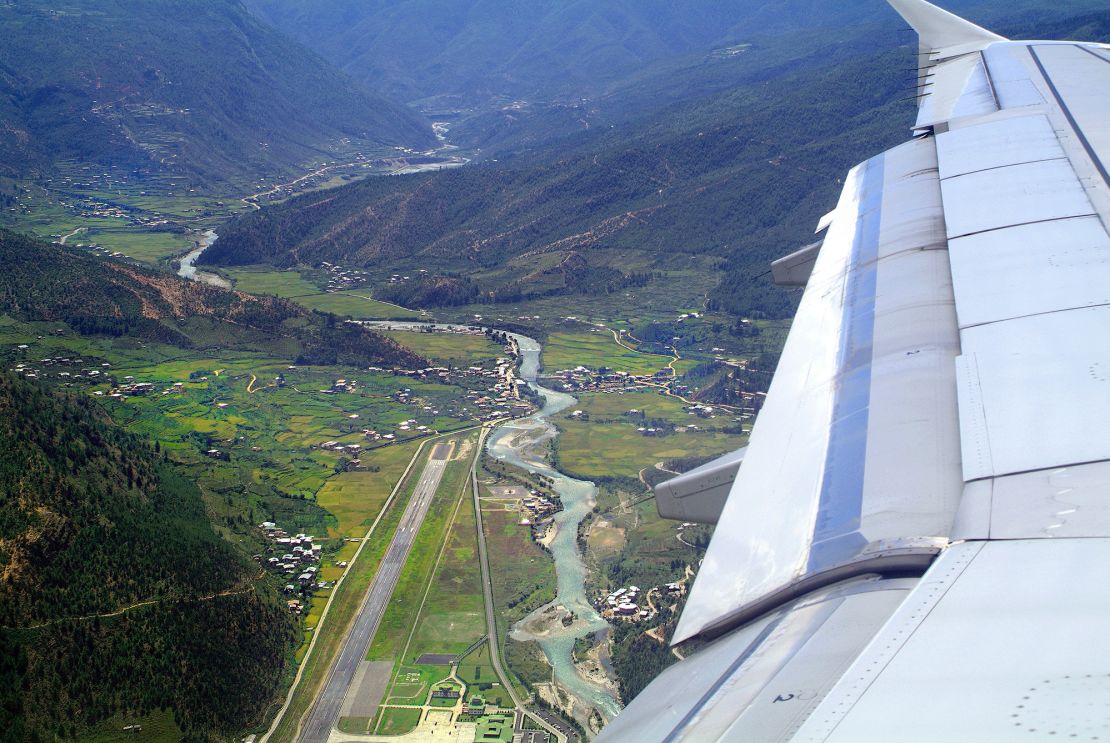There’s a Buddha in the cockpit. The orange-robed icon looks on as the pilot speedily executes a dramatic last-minute turn to land the A319 on the slender runway. A dozen passengers, some of whom have spent the last few minutes white-knuckling the seat armrests, break out into applause.
That’s just another normal working day at Bhutan’s Paro International Airport (PBH), widely considered one of the most technically difficult plane landings in the world. Maneuvering onto a short runway between two 18,000-foot peaks requires both technical knowledge and nerves of steel.
The airport and its challenging conditions have only added to the mystique surrounding travel to Bhutan, a Himalayan kingdom of about 800,000 people.
The unique conditions of flying in and out of Paro mean that jumbo jets are a no-go. But for aviation fans, that’s part of the appeal of visiting the Land of the Thunder Dragon.
First things first: Paro is “difficult, but not dangerous,” says Captain Chimi Dorji, who has been working at Bhutan’s national state-owned airline, Druk Air (aka Royal Bhutan Airlines), for 25 years.
“It is challenging on the skill of the pilot, but it’s not dangerous, because if it were dangerous, I wouldn’t be flying.”
What makes Paro unique

A combination of geographic factors make Paro – and much of Bhutan – visually stunning. They also make flying in and out of Paro a highly specialized skill.
Paro is a category C airport, which means that pilots must have special training to fly there. They must perform the landing themselves manually, without radar. As Dorji says, it’s critical for pilots to know the landscape around the airport – mess it up by even a fraction of an inch, and you could land on top of someone’s house.
“In Paro, you really need to have the local skills and local knowledge area competence. We call it area competence training or area training or route training from flying from anywhere into Paro,” he tells CNN Travel.
Bhutan, which is located between China and India, is more than 97% mountains. Its capital, Thimpu, is 7,710 feet (2,350 meters) above sea level. Paro is slightly lower, clocking in at 7,382 feet.
“At higher elevations, the air is thinner, so the aircraft essentially has to fly through the air faster,” explains Dorji, who in addition to flying planes now trains Druk Air’s pilots and cabin crew. “Your true airspeed will be the same, but your airspeed as opposed to the ground is much faster.”
The next variable to consider is weather.
Anyone who has flown into Paro – from New Delhi, Bangkok, Kathmandu, or, as of October 2024, Hanoi – most likely had to wake up very early for their flight. That’s because airport officials prefer all planes to land before noon for optimal safety due to strong wind conditions.
“We try to avoid operations beyond noon because then you get a lot of thermal (winds), the temperatures rising, the rains haven’t come in yet,” says Dorji. “So land is parched and you get all these up drops and get all these anabatic/katabatic winds in the valley in the afternoon. Mornings are much calmer.”
That is less of an issue with takeoffs, though, so travelers can count on a better night’s sleep their last evening in Bhutan thanks to an afternoon departure time.
However, there are no nighttime flights at Paro, regardless of the season, due to the lack of radar.
Different accommodations have to be made during monsoon season, which is usually between June and August.
It’s not uncommon to have thunderstorms that time of year, complete with hail that can reach the size of golf balls.
“The monsoon is across the Bay of Bengal,” Dorji says. “You have these northwesterly, northeasterly winds that come in from across in China. And you have these periods where you have rain for days.”
Ultimately, he says, part of a pilot’s training isn’t just knowing how to fly – it’s knowing when not to fly, and being able to make the call when it isn’t a safe time to take off.
The last factor in Paro’s level of difficulty is what Dorji calls “obstacles” – namely, the mountainous terrain that surrounds the airport.
Paro’s runway is just 7,431 feet long, and it’s flanked by two tall mountains. As a result, pilots can only see the runway from the air when they’re just about to land on it.
Bhutan’s aviation industry
Things are changing in Bhutan, and the aviation industry is one of them.
Gelephu, in southern Bhutan near the Indian border, has been chosen as the site for a new purpose-built “mindfulness city.”
While it’s already home to a small airport, Gelephu’s new status brings a significant expansion. The most notable difference between Gelephu and Paro is terrain – Gelephu is much flatter and there is enough room to build longer runways that are easier for non-specialized pilots and can accommodate jumbo jets.
Within a few years, it’s possible there will be direct flights to Bhutan from North America, Europe and the Middle East.
The industry is still relatively young here. Druk Air was founded in 1981 – compare that with 1919 for KLM, 1920 for Qantas and 1928 for Delta Air Lines.
And while Bhutan only has a few dozen licensed pilots, there is a stated national interest in hiring and training more young pilots locally, not just recruiting from overseas.
Aspiring pilots must show their ability to fly in all of Bhutan’s varied seasons. As the national flag carrier, Druk Air has taken much of the responsibility for pilot training on itself.
“I consider myself … the bridge between the old generation and the new one,” says Dorji, who is 43. He believes there are 50 licensed pilots in Bhutan, but that number could easily double in the next few years.
Either way, he says, “I’m looking forward to it.”






